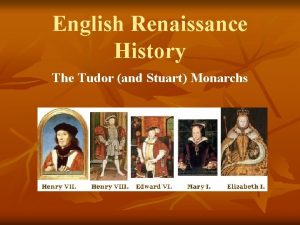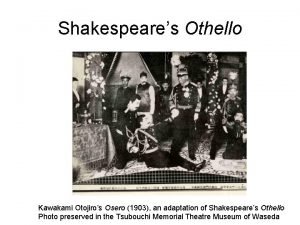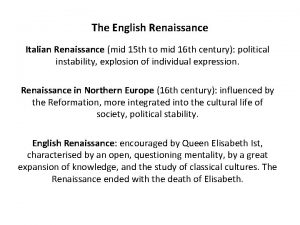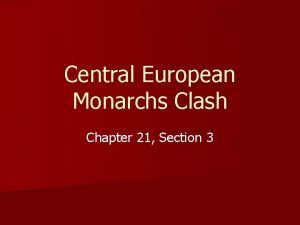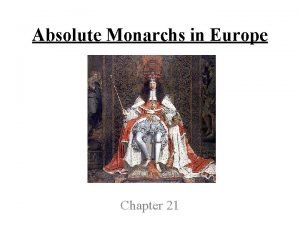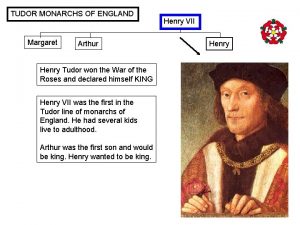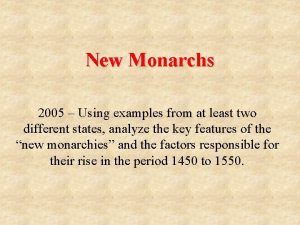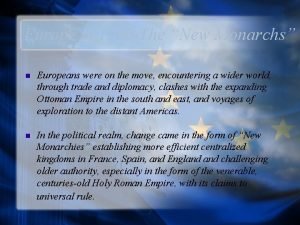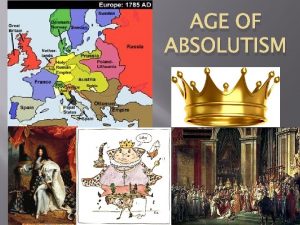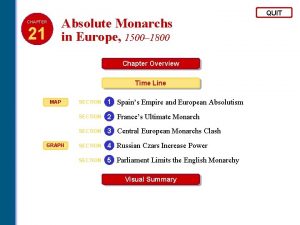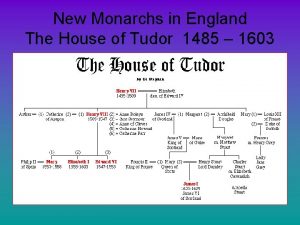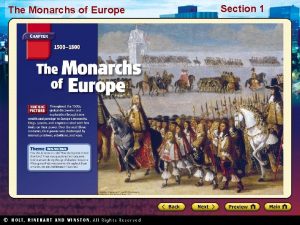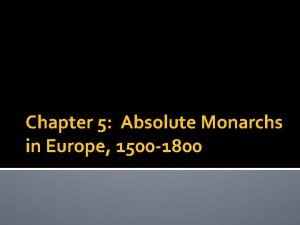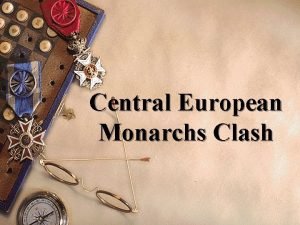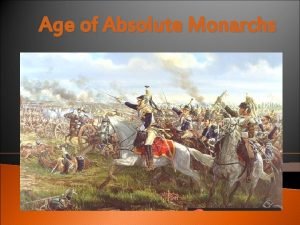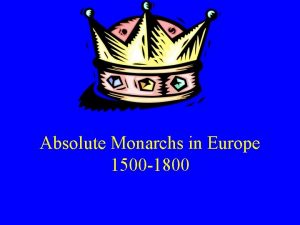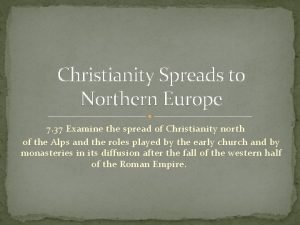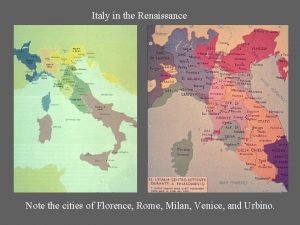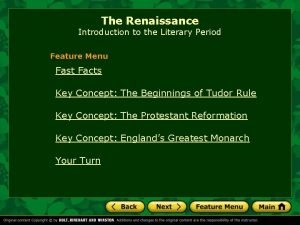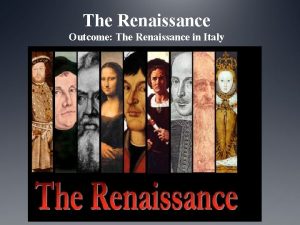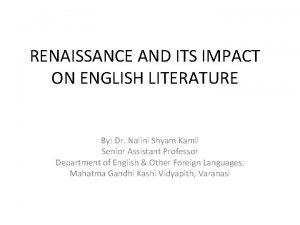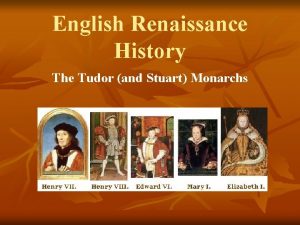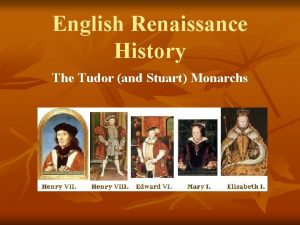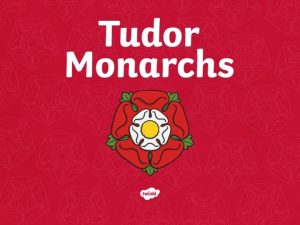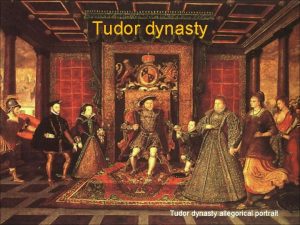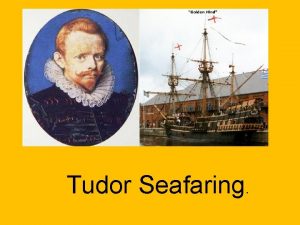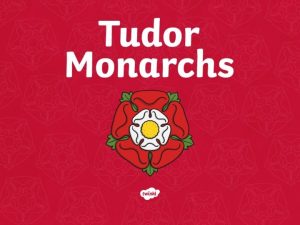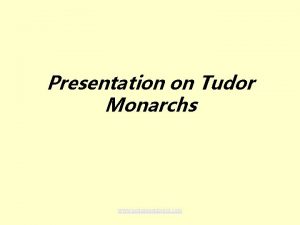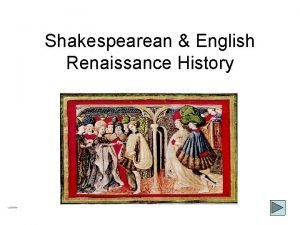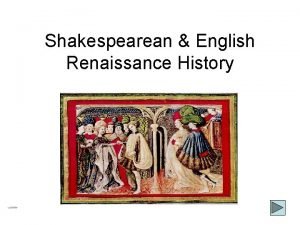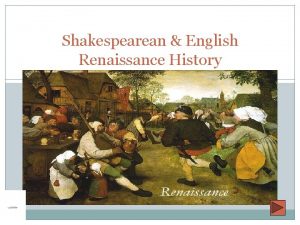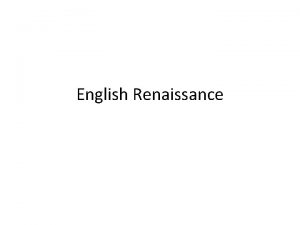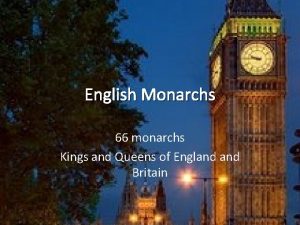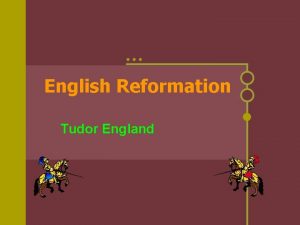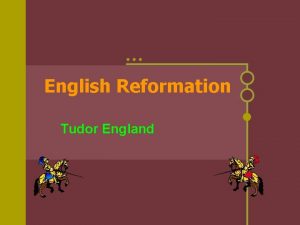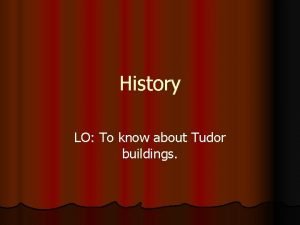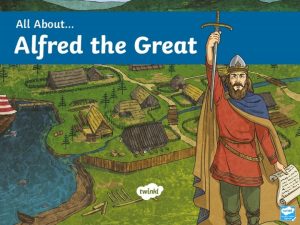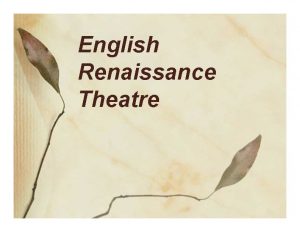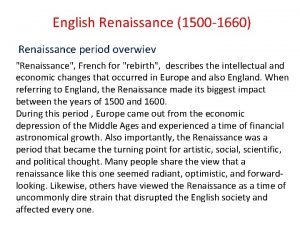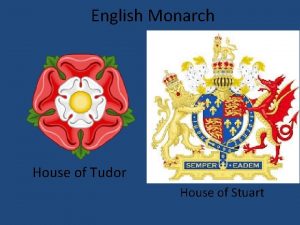English Renaissance History The Tudor and Stuart Monarchs


























- Slides: 26

English Renaissance History The Tudor (and Stuart) Monarchs




King Henry After his elder brother Arthur died, Henry VIII became heir to the throne. v Spain and England wanted to keep their alliance, even w/ Arthur’s death v So Henry married Catherine of Aragon, Arthur’s widow v. Later he tried to annul this marriage so he could marry Anne Boleyn. v Henry claimed that God punished him by denying him a legitimate male heir – in Leviticus, God does threaten childlessness if a man marries his brother’s widow…so Henry came to see this marriage as cursed… v

I need a son. I have been married for 20 years and my wife, Catherine of Aragon is too old to have any more children. Who will inherit my throne when I die? I spy an attractive lady – in-waiting called Anne Boleyn. If only I could marry her instead. Will the Pope give me a divorce? The Church is very rich. I need money for my luxurious court. If only I could get my hands on it. The new Protestant ideas are spreading in Germany. Princes there are reforming their churches and throwing out the Catholic Church. The Church takes money out my country in taxes to help build St Peter’s in Rome. What do I get in return? Some people in England like the new Protestant ideas. They believe that the Bible should be in English not Latin.

Catharine of Aragon Catharine was the daughter of Isabella and Ferdinand of Spain. v. She was married to Arthur, Henry VII’s heir, but he died, apparently before the marriage was consummated. v. Later she married Henry VIII, but they only had one living child, Mary. (They had a son who died in infancy). v. All of these issues reached the boiling point after 20 yrs. b/c of constant succession worries, Catharine’s diminishing looks, and the appearance of Anne Boleyn… v

Henry’s Wives Catherine of Aragon (1509 -1533) Anne of Cleves (1540) Anne Boleyn 1536) (1533 - Catherine Howard (1540 -1542) Jane Seymour -1537) Katherine Parr (1543 -1547) (1536

Henry VIII (cont. ) When he wanted to marry Anne Boleyn, Henry created the Church of England banned the Catholic Church from his nation. He also seized all of the property of the Catholic Church, thereby increasing the wealth of England.

Anne Boleyn Anne became Henry VIII’s second wife. But since his first, Catharine of Aragon, was still living, many Catholics, felt that her child Elizabeth was illegitimate. v. When Anne failed to produce a male heir, there were rumours that she was infertile…and by that time Henry had met Jane Seymour. v. Anne tried to woo Henry back, but he had her charged with adultery and incest and beheaded… v

n n Elizabeth and Mary were raised together Queen Jane Seymour showed favour to Mary but treated Elizabeth well And the Queen did finally have that male heir, Edward VI; this ended the sisters’ succession argument When Jane Seymour died (a fever), the 3 siblings were raised together

n n Henry VIII went on to marry Anne of Cleves – it only lasted 6 months, and Henry got out of it by saying he was impotent on the wedding night… Henry then married Catherine Howard, a 17 year old, who was soon beheaded for adultery So Henry married for the final time, to Catherine Parr – she got along well with all the children Elizabeth stayed the 3 rd lady of the court – only the Habsburgs still called the “whore’s daughter”

Edward VI He was the son of Henry VIII and Jane Seymour - a Protestant who became king at the age of 9. v. The Church of England expanded while he was king. v. But he was sickly and died at the age of 16. v. During his kingship, England was largely under the rule of Edward’s council, which included Thomas Seymour (the Duke of Somerset)… v

Elizabeth fell in love with Thomas Seymour, and he wanted to marry either Elizabeth or Mary (but they could only marry w/ the permission of the entire council), so Seymour instead married Catherine Parr (Henry’s widow) – as Elizabeth lived w/ Parr, this made Seymour her stepfather and guardian (and it is likely that he abused her during this time) v When Parr died in childbirth, she had left all to Seymour in an oral will v

Jane Grey In need of a lady of the household, he brought in Lady Jane Grey (Henry VIII’s grand-niece), saying he would marry her off to Edward VI v Seymour wanted Lady Jane Grey as the next queen, as opposed to Edward’s sister Mary, who was Catholic. (Seymour’s son had married Jane Grey. ) v in 1549, Edward passed the Act of Uniformity, introducing the Protestant Prayer Book – Mary looked to Catholic Spain and her cousin Charles V for assistance – basically, she disobeyed her brother and father… v. So all the fundamental 16 th century values came into conflict – religion, patriotism, the law, dynastic succession… v

v v v Edward opted for religion and plotted to get rid of Mary (and Elizabeth, as he thought she would not go along w/ him) Edward thought succession would go to the male descendants of Mary Tudor (Henry VIII’s sister) There were no male heirs at that time, but it was assumed someone would have a son eventually…but then Edward’s health went into rapid decline, and time was running out On his deathbed, Edward changed his will to indicate that Lady Jane Grey (and not her male heirs) should succeed him When Edward died, Jane became the queen, but Mary also proclaimed herself the queen – when Jane’s army faltered, the council abandoned her When Mary recaptured the throne she had Seymour and Jane executed (Jane was queen for 9 days). . .


Mary I (Bloody Mary) Mary was the daughter of Henry VIII and Catharine of Aragon. v. During her childhood, Mary was persecuted by Henry when he wanted to annul his marriage to her mother. v. As Queen she attempted to restore Catholicism, and she married the young Philip from Spain. v. She also had more than 300 Protestants killed. v. None of these actions was popular with the now firmly entrenched Protestant England v

n When Mary died peacefully, Elizabeth acceded to the throne peacefully – she was proclaimed in only 6 hrs. as having the “lawful right and title to the crown”

Elizabeth I The red-haired daughter of Henry VIII and Anne Boleyn, she became England’s greatest leader. She kept control of England by refusing to marry anyone and playing one noble against another – many hoping to marry the Queen. She kept religious wars down, advanced exploration, became a patron of the arts, and brought England to the position of world power with the defeat of the Spanish Armada

n n Elizabeth worked hard to avoid religious conflict She also organized public debates on religion, where the Protestants were given every advantage With that, the Church of England was again entrenched oaths were required, but she kept the punishments for “heresy” light…Catholics went into hiding, but she largely turned a blind eye as long as public demonstrations didn’t occur She also kept a certain degree of church ceremony; as a monarch, she saw the advantage of ritual


Mary (Stuart), Queen of Scots English Catholics believed that she was the only legitimate heir to English throne after Mary I’s death – they rallied around her. v. Given the threat, Mary was brought to England as a “guest” (prisoner) v. This again raised the succession issue… v

v v v The Pope entered into things, saying Elizabeth was a heretic…so Elizabeth became a more hard-line Protestant At this pt, English Catholics turned to Spain for help (and Spain was anti-Elizabeth as she supported piracy in the New World and had aided the Dutch Revolt) When proof of Mary’s treachery came to light, Elizabeth I had her executed…Spain attacked, but the Armada failed…

JAMES I v v James I of England was James VI of Scotland. His mother was Mary Queen of Scots, and at Elizabeth I’s death, James was named her heir. A Catholic, he was known for the authorization of the King James Version of the Bible, as well as for being the “Wisest Fool in Christendom”.

• Compare your notes to your partners. What should you have added on the blank lines? • How did politics and religion intersect during the reign of the Tudors in England (1500 s-1603)?
 Tudor and stuart monarchs
Tudor and stuart monarchs Tudor and stuart family tree
Tudor and stuart family tree Italian renaissance vs english renaissance
Italian renaissance vs english renaissance Central european monarchs clash
Central european monarchs clash Chapter 5 section 3 central european monarchs clash
Chapter 5 section 3 central european monarchs clash Spain's empire and european absolutism chapter 21 section 1
Spain's empire and european absolutism chapter 21 section 1 Monarchs of england
Monarchs of england New monarchs examples
New monarchs examples New monarchs examples
New monarchs examples Age of absolute monarchs worksheet answer key
Age of absolute monarchs worksheet answer key Chapter 5 absolute monarchs in europe answer key
Chapter 5 absolute monarchs in europe answer key Age of absolute monarchs
Age of absolute monarchs New monarchs
New monarchs Chapter 5 absolute monarchs in europe
Chapter 5 absolute monarchs in europe 5 monarchs of europe
5 monarchs of europe Central european monarchs clash
Central european monarchs clash Monarchs newbury park
Monarchs newbury park Bourbon absolutism
Bourbon absolutism Characteristics of absolute monarchs
Characteristics of absolute monarchs Cosimo de' medici
Cosimo de' medici Italian renaissance vs northern renaissance venn diagram
Italian renaissance vs northern renaissance venn diagram The renaissance outcome renaissance painters/sculptors
The renaissance outcome renaissance painters/sculptors Italian renaissance vs northern renaissance
Italian renaissance vs northern renaissance Last supper labeled
Last supper labeled The renaissance introduction to the renaissance answer key
The renaissance introduction to the renaissance answer key The renaissance outcome the renaissance in italy
The renaissance outcome the renaissance in italy Define the term renaissance
Define the term renaissance
